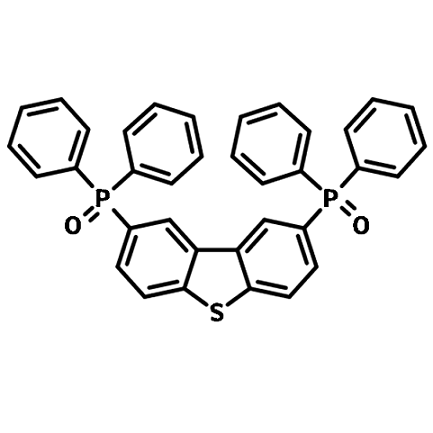PPT, PO15
CAS Number 1019842-99-9
Charge Transport Layer Materials, Electron Transport Layer Materials, Fluorescent Host Materials, High Purity Sublimed Materials, Host Materials, Materials,PO15, an ambipolar phosphorescent host material
Used to enhance electroluminescence efficiency
PPT (CAS number 1019842-99-9) is an ambipolar phosphorescent host material with an electron-rich dibenzothiophene core and two electron-deficient diphenyl-phosphoryl side arms. For this reason, PPT is a good electron-transport material with higher electron mobility rate, offering better electron injection.
Its wide bandgap and high triplet energy level creates highly-efficient TADF-OLED devices, PPT is normally used to host blue light-emitting materials (such as FIrPic). PPT is also used with electron-donating materials to form exciplexes with delayed fluorescence to enhance electroluminescence efficiency.
PPT is one the first reported organic LPL (OLPL) systems of two simple organic molecules that are free from rare elements such as strontium, europium and dysprosium. With a simple structure that is easy to fabricate, the device of OLPL system can generate emission lasting for more than an hour at ambient temperatures.
General Information
| CAS number | 1019842-99-9 |
|---|---|
| Full name | 2,8-Bis(diphenyl-phosphoryl)-dibenzo[b,d]thiophene |
| Chemical formula | C36H26O2P2S |
| Molecular weight | 584.60 g/mol |
| Absorption | λmax 312, 328 nm in DCM |
| Fluorescence | λem 350 nm in DCM |
| HOMO/LUMO | HOMO = 6.7 eV, LUMO = 3.0 eV (ET = 3.1 eV) [1] |
| Synonyms | DPDT, PO15 |
| Classification / Family | Dibenzothiophene derivatives, Organic electronics, Electron-transport layer materials (ETL), Phosphorescent host materials, TADF-OLEDs, Organic long persistent luminescence, Sublimed materials. |
Product Details
| Purity | Sublimed: >99.0% (HPLC) |
|---|---|
| Melting point | TGA: >320 °C (0.5% weight loss) |
| Appearance | Off-white powder/crystals |
*Sublimation is a technique used to obtain ultra pure-grade chemicals. For more details about sublimation, please refer to the Sublimed Materials.
Chemical Structure

Device Structure(s)
| Device structure | ITO/m-MTDATA (35 nm)/50 mol.% m-MTDATA:PPT (30 nm)/PPT (35 nm)/LiF (0.8 nm)/Al [1] |
|---|---|
| Colour | Orange |
| Max. EQE | 10% |
| Max. Power Efficiency | 47.0 lm W-1 |
| Device structure | ITO/TAPC (40 nm)/TCTA (2 nm)/26DCzPPy:TCTA:FIrpic (0.4:0.4:0.2) (5 nm)/26DCzPPy:PPT:FIrpic (0.4:0.4:0.2) (5 nm)/3TPYMB (55 nm)/CsF (2 nm)/Al (180 nm) [2] |
|---|---|
| Colour | Blue |
| Power Efficiency @ 1000 cd/m2 | 30 lm W−1 |
| Current Efficiency @ 1000 cd/m2 | 42 cd/A |
| Device structure | ITO/HATCN (10 nm)/Tris-PCz (35 nm)/10 wt. % 4CzPN:mCBP (G-EML) (5 nm)/6 wt. % 4CzPN:2 wt. % 4CzTPN-Ph:mCBP (R-EML) (4 nm)/10 wt. % 3CzTRZ:PPT (B-EML) (6 nm)/PPT (50 nm)/LiF (0.8 nm)/Al (100 nm) [3] |
|---|---|
| Colour | White |
| Max. Current Efficiency | 13.13 cd/A |
| Max. EQE | 6.8% |
| Max. Power Efficiency | 4.75 lm W-1 |
*For chemical structure information, please refer to the cited references.
Pricing
| Grade | Order Code | Quantity | Price |
|---|---|---|---|
| Sublimed (>99.0% purity) | M2132A1 | 250 mg | £260 |
| Sublimed (>99.0% purity) | M2132A1 | 500 mg | £460 |
| Sublimed (>99.0% purity) | M2132A1 | 1 g | £800 |
MSDS Documentation
Literature and Reviews
- Efficient organic light-emitting diodes through up-conversion from triplet to singlet excited states of exciplexes, K. Goushi et al., Appl. Phys. Lett. 101, 023306 (2012); doi: 10.1063/1.4737006.
- Blue and white phosphorescent organic light emitting diode performance improvementbyconfining electrons and holes inside double emitting layers, Y-S.Tsai et al., J. Luminescence 153, 312–316 (2014); doi: 10.1016/j.jlumin.2014.03.040.
- High-efficiency white organic light-emitting diodes using thermally activated delayed fluorescence, J. Nishide et al., Appl. Phys. Lett. 104, 233304 (2014); doi: 10.1063/1.4882456.

 PPT MSDS sheet
PPT MSDS sheet